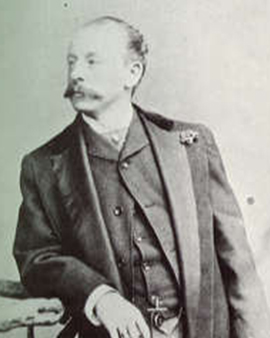


At the turn of the 19th century, the desire to find one's own happiness on distant continents pervaded Europe. America appeared as a country where anything was possible. Alfred Thompson Bricher's parents joined the train, and so the artist was born on American soil. The country was still largely unknown and urbanization low. New York was considered the center of art. It was here that Europeans took their first step into the new life and brought with them the European currents of art and culture. In America, an artists' association was founded, whose work became known as the Hudson River School. The founder of the artist group was Thomas Cole. The artists were landscape painters and their representations concentrated on the landscapes of America. Their intention reflected the most important areas of America at that time. The discovery of the country, the exploration of the unknown and the progressive settlement of the eastern parts of the country.
Alfred Thompson Bricher took up a profession and at the same time devoted himself to studying art. The artist began to travel and explore. During the summer months Bricher visited the coasts of Maine and Massachusetts and made drawings and sketches. During the winter months, the painter retreated to his studio and painted. He liked to immerse himself in water landscapes, which he executed with great perfection. Bricher devoted himself calmly and precisely to the motifs with great dedication. It could happen that the artist created new landscapes as individual segments of his drawings. In addition to his love of art, the artist demonstrated economic skill and sold a large number of his paintings to a company. The works were produced as chromolithographs and extended the artist's reputation. With the financial freedom and security provided by bullets, Alfred Bricher's travel radius expanded. Bricher became part of a group of artists who visited the Niagara Falls and got in touch with the rushing water masses on canvas.
Alfred Thompson Bricher was closely connected with water. In his homes in Southampton and on Staten Island he spent the late phase of his creative period. The light and the water inspired the artist to capture the light effects. Photography was invented and developed into a medium of light. Many painters saw themselves in a position to compete with the new technique and to view light more intensely. They developed away from the romanticism in paintings that had been striven for until then. The goal became a realistic mode of representation that had a documentary quality. An art historian later coined the term American Luminism. An art movement that developed in the late phase of the Hudson River School. On the one hand, it describes the preference for light effects in painting and is considered the American forerunner of Impressionism.

At the turn of the 19th century, the desire to find one's own happiness on distant continents pervaded Europe. America appeared as a country where anything was possible. Alfred Thompson Bricher's parents joined the train, and so the artist was born on American soil. The country was still largely unknown and urbanization low. New York was considered the center of art. It was here that Europeans took their first step into the new life and brought with them the European currents of art and culture. In America, an artists' association was founded, whose work became known as the Hudson River School. The founder of the artist group was Thomas Cole. The artists were landscape painters and their representations concentrated on the landscapes of America. Their intention reflected the most important areas of America at that time. The discovery of the country, the exploration of the unknown and the progressive settlement of the eastern parts of the country.
Alfred Thompson Bricher took up a profession and at the same time devoted himself to studying art. The artist began to travel and explore. During the summer months Bricher visited the coasts of Maine and Massachusetts and made drawings and sketches. During the winter months, the painter retreated to his studio and painted. He liked to immerse himself in water landscapes, which he executed with great perfection. Bricher devoted himself calmly and precisely to the motifs with great dedication. It could happen that the artist created new landscapes as individual segments of his drawings. In addition to his love of art, the artist demonstrated economic skill and sold a large number of his paintings to a company. The works were produced as chromolithographs and extended the artist's reputation. With the financial freedom and security provided by bullets, Alfred Bricher's travel radius expanded. Bricher became part of a group of artists who visited the Niagara Falls and got in touch with the rushing water masses on canvas.
Alfred Thompson Bricher was closely connected with water. In his homes in Southampton and on Staten Island he spent the late phase of his creative period. The light and the water inspired the artist to capture the light effects. Photography was invented and developed into a medium of light. Many painters saw themselves in a position to compete with the new technique and to view light more intensely. They developed away from the romanticism in paintings that had been striven for until then. The goal became a realistic mode of representation that had a documentary quality. An art historian later coined the term American Luminism. An art movement that developed in the late phase of the Hudson River School. On the one hand, it describes the preference for light effects in painting and is considered the American forerunner of Impressionism.
Page 1 / 1






